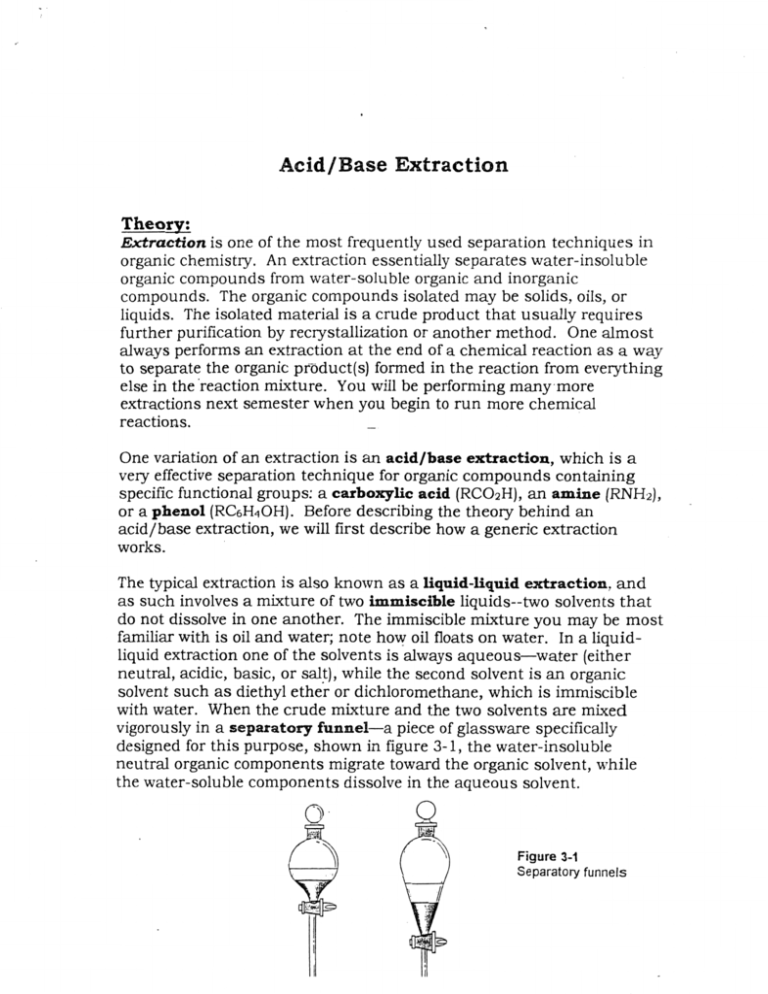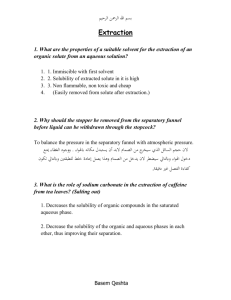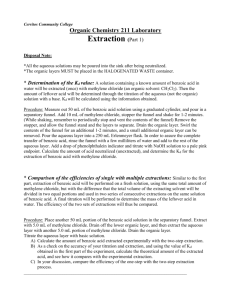Acid/Base Extraction
advertisement

Acid/Base Extraction Theory: Extraction is one of the most frequently used separation techniques in organic chemistry. An extraction essentially separates water-insoluble organic compounds from water-soluble organic and inorganic compounds. The organic compounds isolated may be solids, oils, or liquids. The isolated material is a crude product that usually requires further purification by recrystallization or another method. One almost always performs an extraction at the end of a chemical reaction as a way to separate the organic product(s) formed in the reaction from everything else in the reaction mixture. You will be performing many more extractions next semester when you begin to run more chemical reactions. _ One variation of an extraction is an acid/base extraction, which is a very effective separation technique for organic compounds containing specific functional groups: a carboxylic acid (RCO2H), an amine (RNH2), or a phenol (RC6H4OH). Before describing the theory behind an acid/base extraction, we will first describe how a generic extraction works. The typical extraction is also known as a liquid-liquid extraction, and as such involves a mixture of two immiscible liquids—two solvents that do not dissolve in one another. The immiscible mixture you may be most familiar with is oil and water; note how oil floats on water. In a liquidliquid extraction one of the solvents is always aqueous—water (either neutral, acidic, basic, or salt), while the second solvent is an organic solvent such as diethyl ether or dichloromethane, which is immiscible with water. When the crude mixture and the two solvents are mixed vigorously in a separatory funnel—a piece of glassware specifically designed for this purpose, shown in figure 3-1, the water-insoluble neutral organic components migrate toward the organic solvent, while the water-soluble components dissolve in the aqueous solvent. Figure 3-1 Separatory funnels This is known as partitioning between the two layers. The physical principle operating here is one we have seen before: "like dissolves like." In other words, a substance will dissolve best in the solvent with the most similar polarity characteristics to its own. As a general rule, water will dissolve salts, including organic ions, and substances with strong hydrogen bonding characteristics and very little hydrocarbon structure; whereas, organic solvents will dissolve neutral organic substances with weak intermolecular forces, i.e. compounds containing significant hydrocarbon structure and few hydrogen bonding interactions relative to hydrocarbon character. Once the separatory funnel has been shaken vigorously, it is placed in a ring clamp and the two immiscible solvents quickly separate into two distinct layers, with the less dense solvent layer residing on top. Novices often find it difficult to determine which layer is which. If you always remember that the less dense layer is on top, this step will be easier. You can look up the density of solvents in the Aldrich catalog or another reference text; however, as a general rule of thumb, chlorinated organic solvents are more dense than water, whereas n^~chloriiial£d^org^ul^ solvents are less dense than water. One then simply separates the two layers by removing the stopper and opening the stopcock at the bottom of the separatory funnel and allowing each la}^er to carefully drain into two separate labeled Erlenmeyer flasks. These layers are then referred to as the aqueous extract and the organic extract. Since partitioning of substances into their respective solvent layers is never perfect, i.e. some organic material remains in the aqueous extract, and visa versa, one typically returns the aqueous extract to the separatory funnel and adds fresh organic solvent and repeats the extraction process a couple more times. Calculations show that an extraction is more effective when performed three times with 20 mL of solvent than one time with 60 mL of solvent. This is the case anytime a solute is distributed between two immiscible solvents. The amount of solute in g/mL in each solvent phase is expressed quantitatively in terms of the partition coefficient, K: K = [solute A in solvent 1]/[solute A in solvent 2] At equilibrium, at a given temperature, the ratio of concentrations of A in the two phases will always be constant. For example, if the partition coefficient, K, for a compound partitioned between diethyl ether and water is 3.0; this means the compound preferentially partitions into ether over water by a factor of 3. So if you have 12 g of compound being partitioned between 60 mL of water and 60 mL of ether, the ether layer will contain 9g of material and the water layer will contain 3 g of material after one extraction. If you do the extraction 3 times with 20 mL of solvent, then the 3g in the water layer after the first extraction will now partion in a way to give K=3 again, so 2.25 g will be in the organic layer and .75 g will be in the water layer (2.25/.75=3). Returning the water layer to the separatory funnel and extracting for a third time with 20 mL of fresh ether will cause the .75 g to partition between the layers so that K=3, again. Thus, .56 g of compound is in the organic extract and . 19 g is in the water layer (.56/. 19=3). Now when you combine the three organic extracts you get 11.8 g (.56 + 2.25 + 9 g) of the original 12 g, whereas if you did only one extraction you would recover only 9 g of material. Notice also that with each additional extraction a smaller percentage of the solute is obtained, so doing 4 or 5 extractions would not increase your yield significantly, and would not be worth the extra "effort. On the other hand the second and third extractions do contain significant amounts of solute, and even more so the lower the value of K. This calculation was somewhat simplified, since the partition coefficient is probably somewhat smaller when the lesser volume of organic solvent is used. It is for this reason that whenever an extraction is performed it is done multiple times. The value of the partition coefficient depends on the identity of the solute and the solvents. The final step of an extraction concludes with removal of the solvent by evaporation or distillation to yield the pure solute. In the variation of an extraction known as an acid/base extraction the same principles as those described above apply. The most important difference is that the aqueous solvent- water, is not neutral; it is either acidic or basic. For most organic functional groups this has no impact, but for carboxylic acids, amines, and phenols, an acid base reaction ^^ of the mixture that reverses jj__ly jtj_s_olubility ~ diaracjteristicsTThis is^e^nnu^FaTe^^yTHFacid/base reaction that occurs with a carboxylic acid when extracted with aqueous base. The reaction is shown below: RCOOH + NaOH (aq) water-insoluble -> RCOO Na+ (aq) + water-soluble H2O As the equation shows, most carboxylic acids are insoluble in water (the exceptions are low molecular weight carboxylic acids), because they are neutral and contain a fair amount of hydrocarbon character relative to hydrogen bonding of the carboxylic acid functional group. However, when base (hydroxide, carbonate, or bicarbonate) removes a proton from the carboxylic acid, a carboxylate salt is produced, which is an organic ion, and like any salt it will dissolve more readily in aqueous solvent than organic solvent. So, now when the two layers are separated in the usual fashion, the aqueous layer, not the organic layer, contains one of the compounds of interest. The carboxylate ion is then restored to its original carboxylic acid form by another acid base reaction as shown below. RCOO- Na+ (aq) + water-soluble HC1 (aq) -> RCOOH + NaCl (aq) water-insoluble This acid base reaction is usually performed directly in the Erlenmeyer flask. Since the carboxylic acid becomes neutral again, it also becomes insoluble in water and precipitates from solution. Suction filtration can then be used to recover the pure carboxylic acid crystals. Note, bicarbonate and carbonate bases work equally well but also produce carbon dioxide gas in the process. A similar reaction occurs with phenols, except that since they are less acidic than carboxylic acids, they can only be deprotonated with the stronger hydroxide bases and not the carbonate and bicarbonate bases. This can be advantageous when separating phenols from carboxylic acids. Note that an acid/base reaction does not occur with ordinary alcohols; they are not sufficiently acidic. ArOH + NaOH (aq) -» ArO Na+ (aq) + H2O Compounds with an amine functional group can be converted into the amine hydrochloride by treatment with aqueous HC1, and in an analogous manner to the carboxylic acids, are converted from an organic soluble substance to an organic insoluble salt that becomes soluble in water as shown in the acid/base reaction below: RNH2 + HC1 (aq) water insoluble -> RNH3+ Cl- (aq) water soluble Obviously, the difference from the carboxylic acid case is that addition of acid not base achieves salt formation and the salt is a cation instead of an anion. Either way it is a charge that causes it to be soluble in water. The aqueous extract containing the amine hydrochloride is drained into an Erlenmeyer flask, and is returned to the neutral amine form by treatment with sodium hydroxide. Since this acid/base reaction causes the organic substance to go from the water-soluble salt form into the water-insoluble neutral form, it precipitates from solution. The reaction is shown below. Once again, isolation is accomplished by a suction filtration. RNH3+ NaOH (aq) —--» water soluble RNH-2 + NaCl (aq) + H2O water insoluble In summary, in a standard extraction carboxylic acids, amines, phenols and other organic compounds would all dissolve in the organic extract; however, when an acid/base extraction is performed, one can selectively remove the phenol with sodium hydroxide, the carboxylic acid with bicarbonate or sodium hydroxide, and the amine with HC1. All other organic substances remain in the organic extract. Incidentally, all inorganic substances are removed in the aqueous extract. This a powerful and simple technique for isolating certain organic compounds. Experimental Acid Base Extraction of a Mixture of Benzoic Acid, 4-nitroaniline, and Naphthalene. You will be provided with an equal mixture of benzoic acid, a carboxylic acid; 4-nitroaniline, an amine; and naphthalene, a neutral organic compound. Using the technique of acid/base extraction your goal is to separate these three compounds and isolate them each in their pure form. Calculate a total % recovery and perform a melting point determination on each of the three solids to analyse the effectiveness of your separation. O2N Benzoic Acid 4-Nitroaniline Naphthalene Begin by dissolving your mixture in 50 mL of dichloromethane and transfer the solution to a 125 mL separatory funnel (remember to close the stopcock first and double check that it doesn't leak). Next you will extract the organic solvent three times with 6M HC1. To do this add 25 mL of 6M HC1 to the separatory funnel. Place the stopcock on the separatoiy funnel and shake vigorously with frequent venting. Your instructor will show you how to do this properly. It is very important that you always remember to vent a separatory funnel frequently to avoid solvent vapors from building-up and blowing the stopcock off. It is also a good idea to wear gloves when handling a separatory funnel, in the event of any spillage. Place the separatory funnel in its ring stand and let the two layers separate. Open the stopcock slowly and allow each layer to drain into two separate labeled 250 mL Erlenmeyer flasks, being especially observant that you make the cut between the layers at the right moment. Return the organic layer to the separator/ funnel and repeat the process two more times, each time with 25 mL of fresh 6M HC1. You may combine the aqueous extracts when draining the separatory funnel each time. Label the flask "HC1 extract," and set it aside. This flask contains the aqueous 4-nitroaniline hydrochloride salt. Return the organic extract to the separatory funnel and extract it three times with 3M NaOH. This should be done in the same way as described above but using 25 mL of 3M NaOH each time. Set aside the combined aqueous extracts and label it "NaOH extract." This flask contains the aqueous sodium benzoate salt. The remaining organic extract now contains only naphthalene, because this substance is unchanged in both the HC1 and NaOH washes; remaining neutral at all times. In order to isolate the pure naphthalene, one first typically removes any residual water that is present as a result of the numerous aqueous extractions. This is done by washing the organic extract with an aqueous saturated sodium chloride solution. The salt draws the water out of the organic layer and into the aqueous. To do this, return the organic extract to the separatory funnel and add about 25 mL of saturated aqueous sodium chloride solution. Shake the separatory funnel and separate the layers in the usual fashion. Add approximately .5 g (estimate do not weigh) of sodium sulfate, a drying agent, to the organic extract to remove the last traces of water. After about 5 minutes, gravity filter the drying agent from the organic solution. A gravity filtration is set up as shown in figure 3-2. Place a powder funnel in a clean dry tared Erlenmeyer flask and place a fluted filter paper in the funnel so that it fits the entire funnel. _Ring Fluted filter paper support Shortstemmed funnel or a powder funnel Erlenmeyer flask Figure 3-2 Your instructor will show you how to flute a piece of filter paper. Now carefully pour the organic solution containing the drying agent into the filter paper and allow it to drain through the paper by gravity, to remove the drying agent. Place the flask containing the filtrate (naphthalene and dichloromethane) in the hood to evaporate the dichloromethane solvent. When you return the following week your flask should contain pure naphthalene. This is a good stopping point. Be sure to label your flasks with your name and place them in the "work in progress hood." Weigh the flask and determine the mass of recovered naphthalene. Scrape the naphthalene out of the flask with a spatula and transfer it to a labeled vial and turn it in to your instructor. Save a small amount for a melting point determination. Place the "HC1 extract" in an ice-cooled water bath. Then carefully add 3M aqueous NaOH until the solution is basic. Test the pH of the solution by placing a drop of solution on pH indicator paper; do not dip the indicator paper into the solution. -You should observe crystals precipitating once your solution becomes neutral. These crystals are 4nitroaniline, which can be isolated by suction filtration. Remember to rinse the crystals in the Buchner funnel with a minimum amount of cold water and allow the solid to air dry for several minutes before transferring to a beaker for further drying. You may store the solid in the dessicator to dry. Place the "NaOH extract" in an ice-cooled water bath and in a similar manner add 6M HC1 to the solution until it is acidic (use pH indicator paper). You should see benzoic acid crystals forming as you reach neutrality. Isolate the solid by suction filtration in the same manner as performed with the amine. Obtain melting points on all three products and record these in your notebook. Since there is often some cross contamination in even the best of extractions, the purity of these solids will not be as good as you would observe in a recrystallization; therefore, you may see some melting point depression, nevertheless you should be able to assess whether you were able to successfully separate the three organic compounds from one another. Describe the physical appearance of these solids in your notebook. Turn all three samples into your instructor in vials labeled with both your name and the identity of the sample. Points will be deducted for unlabeled samples. Calculate a total % recovery for the combined samples.





